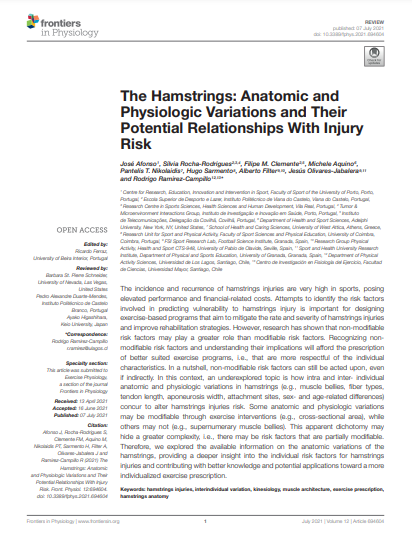The Hamstrings: Anatomic and Physiologic Variations and Their Potential Relationships With Injury Risk

Fecha
2021-07-07Autor
Afonso, Jose
Rocha-Rodrigues, Silvia
Clemente, Filipe M.
Aquino, Michele
Nikolaidis, Pantelis T.
Sarmento, Hugo
Filter, Alberto
Olivares-Jabalera, Jesus
Ramirez-Campillo, Rodrigo [Univ Mayor, Fac Ciencias, Ctr Invest Fisiol Ejercicio, Chile]
Ubicación geográfica
Notas
HERRAMIENTAS
Acceda a títulos restringidos
¿Cómo descargar?Resumen
The incidence and recurrence of hamstrings injuries are very high in sports, posing elevated performance and financial-related costs. Attempts to identify the risk factors involved in predicting vulnerability to hamstrings injury is important for designing exercise-based programs that aim to mitigate the rate and severity of hamstrings injuries and improve rehabilitation strategies. However, research has shown that non-modifiable risk factors may play a greater role than modifiable risk factors. Recognizing non-modifiable risk factors and understanding their implications will afford the prescription of better suited exercise programs, i.e., that are more respectful of the individual characteristics. In a nutshell, non-modifiable risk factors can still be acted upon, even if indirectly. In this context, an underexplored topic is how intra and inter- individual anatomic and physiologic variations in hamstrings (e.g., muscle bellies, fiber types, tendon length, aponeurosis width, attachment sites, sex- and age-related differences) concur to alter hamstrings injuries risk. Some anatomic and physiologic variations may be modifiable through exercise interventions (e.g., cross-sectional area), while others may not (e.g., supernumerary muscle bellies). This apparent dichotomy may hide a greater complexity, i.e., there may be risk factors that are partially modifiable. Therefore, we explored the available information on the anatomic variations of the hamstrings, providing a deeper insight into the individual risk factors for hamstrings injuries and contributing with better knowledge and potential applications toward a more individualized exercise prescription.
URI
https://repositorio.umayor.cl/xmlui/handle/sibum/9046https://www.frontiersin.org/articles/10.3389/fphys.2021.694604/pdf?isPublishedV2=False
https://www.ncbi.nlm.nih.gov/pmc/articles/PMC8294189/pdf/fphys-12-694604.pdf
https://estudogeral.sib.uc.pt/bitstream/10316/104562/1/fphys-12-694604.pdf
https://doi.org/10.3389%2Ffphys.2021.694604
Coleccion/es a la/s que pertenece:
Si usted es autor(a) de este documento y NO desea que su publicación tenga acceso público en este repositorio, por favor complete el formulario aquí.